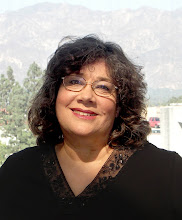I stumped everyone this week. I thought that by showing a photo of the esteemed person holding flowers up, thereby blocking part of his face, someone would make the leap that it was Dr. E=MC
2 himself.
In the 1932 photo above,
Albert Einstein and his wife Elsa are given a huge send-off as they prepare to leave Pasadena after one of their sojourns here.
Here's a more revealing shot:
I did screen captures from a historic video that you'll find
here.
In the early 1930s, Einstein spent three winters in Pasadena, living the first year in a bungalow at 707 S. Oakland Ave. During the following two winters, he resided at
Caltech as a visiting professor and gave prominence to that institution and others. He spent his time working, lecturing and making public appearances here and throughout the greater Los Angeles area.
In January 1933, Einstein and Pasadena stood together as he made a national radio address from the stage of the
Pasadena Civic Auditorium advocating for peaceful relations with Germany.
Here's a photo of him at the curtain that evening:
An answer came back only a few days later when Adolph Hitler became chancellor and the Nazi party made it clear that Einstein, a German and a Jew, would never be welcomed back to Germany. He never again set foot in his native land.
Here he's looking through a telescope at the
Mount Wilson Observatory, accompanied by
Edwin Hubble (center) and observatory director
Walter Adams.
And here he's giving a talk at the
Carnegie Observatories headquarters in Pasadena in 1931:
Many of Caltech's competitors in the annual
Pasadena Collegiate Field Tournament have worn curly white wigs in tribute to the physicist:
In 2005 I co-produced a video titled
"When Einstein Lived in Pasadena" to commemorate the 100th anniversary of his famous
five papers. Institutions throughout the world hosted exhibits and special events throughout the year and traditional media and websites explored his life and career. The City of Pasadena won a national award for the video from the
City-County Communications and Marketing Association (3CMA) that year.
The five groundbreaking papers set traditional scientific theories on their ears and sparked remarkable innovation that continues to this day. In the five papers, the 26-year-old patent clerk proved the existence of atoms, presented his special theory of relativity and put quantum theory on its feet.
When he was awarded his only Nobel Prize in 1921, it was for his work on the photoelectric effect, the basis for today’s quantum theory, which deals with the behavior of matter at the atomic and subatomic level.
These studies were just the beginning for Einstein, who went on to create the general theory of relativity (E=MC
2) and to pioneer quantum mechanics.
Albert Einstein is considered the most significant person in the 20th century and one of the most brilliant minds in history.
And he was all ours for three winters in the 1930s.
Caltech has a nice site
here.
Many thanks to British Pathe, Carnegie Observatories, Caltech and Corbis. The photo at the Pasadena Collegiate Field Tournament was shot by yours truly.
